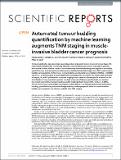Files in this item
Automated tumour budding quantification by machine learning augments TNM staging in muscle-invasive bladder cancer prognosis
Item metadata
| dc.contributor.author | Brieu, Nicolas | |
| dc.contributor.author | Gavriel, Christos | |
| dc.contributor.author | Nearchou, Ines P. | |
| dc.contributor.author | Harrison, David James | |
| dc.contributor.author | Schmidt, Günter | |
| dc.contributor.author | Caie, Peter David | |
| dc.date.accessioned | 2019-03-27T12:30:06Z | |
| dc.date.available | 2019-03-27T12:30:06Z | |
| dc.date.issued | 2019-03-26 | |
| dc.identifier | 258134826 | |
| dc.identifier | d2157e00-08f3-4b6d-9709-1b1d21fde9d9 | |
| dc.identifier | 85063462689 | |
| dc.identifier | 000462298600061 | |
| dc.identifier.citation | Brieu , N , Gavriel , C , Nearchou , I P , Harrison , D J , Schmidt , G & Caie , P D 2019 , ' Automated tumour budding quantification by machine learning augments TNM staging in muscle-invasive bladder cancer prognosis ' , Scientific Reports , vol. 9 , 5174 . https://doi.org/10.1038/s41598-019-41595-2 | en |
| dc.identifier.issn | 2045-2322 | |
| dc.identifier.other | ORCID: /0000-0002-0031-9850/work/60196551 | |
| dc.identifier.other | ORCID: /0000-0001-9041-9988/work/64034266 | |
| dc.identifier.other | ORCID: /0000-0002-1863-5413/work/75610530 | |
| dc.identifier.uri | https://hdl.handle.net/10023/17387 | |
| dc.description.abstract | Tumour budding has been described as an independent prognostic feature in several tumour types. We report for the first time the relationship between tumour budding and survival evaluated in patients with muscle invasive bladder cancer. A machine learning-based methodology was applied to accurately quantify tumour buds across immunofluorescence labelled whole slide images from 100 muscle invasive bladder cancer patients. Furthermore, tumour budding was found to be correlated to TNM (p = 0.00089) and pT (p = 0.0078) staging. A novel classification and regression tree model was constructed to stratify all stage II, III, and IV patients into three new staging criteria based on disease specific survival. For the stratification of non-metastatic patients into high or low risk of disease specific death, our decision tree model reported that tumour budding was the most significant feature (HR = 2.59, p = 0.0091), and no clinical feature was utilised to categorise these patients. Our findings demonstrate that tumour budding, quantified using automated image analysis provides prognostic value for muscle invasive bladder cancer patients and a better model fit than TNM staging. | |
| dc.format.extent | 1817534 | |
| dc.language.iso | eng | |
| dc.relation.ispartof | Scientific Reports | en |
| dc.subject | QA75 Electronic computers. Computer science | en |
| dc.subject | RC0254 Neoplasms. Tumors. Oncology (including Cancer) | en |
| dc.subject | DAS | en |
| dc.subject | SDG 3 - Good Health and Well-being | en |
| dc.subject.lcc | QA75 | en |
| dc.subject.lcc | RC0254 | en |
| dc.title | Automated tumour budding quantification by machine learning augments TNM staging in muscle-invasive bladder cancer prognosis | en |
| dc.type | Journal article | en |
| dc.contributor.institution | University of St Andrews. School of Medicine | en |
| dc.contributor.institution | University of St Andrews. Cellular Medicine Division | en |
| dc.contributor.institution | University of St Andrews. Sir James Mackenzie Institute for Early Diagnosis | en |
| dc.identifier.doi | https://doi.org/10.1038/s41598-019-41595-2 | |
| dc.description.status | Peer reviewed | en |
This item appears in the following Collection(s)
Items in the St Andrews Research Repository are protected by copyright, with all rights reserved, unless otherwise indicated.

